Introduction
Within This Page
Federal buildings, courthouses, customs houses, and border stations have always served two crucial functions in the symbolism and operation of the government. They have the responsibility to express to fellow citizens the stability and endurance of their government, while representing the openness and transparency that is vital to democracy. This responsibility continues to motivate us today, even as we respond to changing security requirements that call for innovative physical solutions.
The U.S. General Services Administration (GSA) sees the evolving need for security as an opportunity—to achieve the best design, contribute to the sustainability and environmental preservation, create a portfolio of buildings that will endure into the future, provide safe and productive federal workplaces, and improve the communities in which we work. In meeting these responsibilities, thoughtful security design can demonstrate and represent permanence and encourage citizen participation. Increased setbacks can become active public spaces, site security elements can serve as seating areas or landscape features, and new amenities can both increase the safety of federal employees and integrate our public buildings into their neighborhoods.
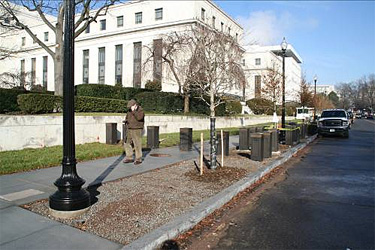
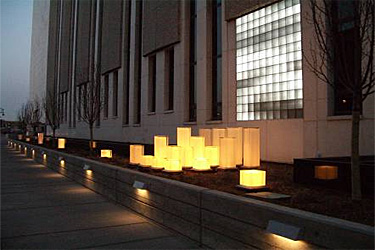
This new process entails looking beyond the scope of buildings to include the surrounding site and community. Only with such an expansive and thorough approach to security, can the result achieve multiple goals and have a positive impact on the community as well as on building occupants.
The inclusion of counterterrorism elements in the design and management of these federal facilities is of prime importance, while the fundamental need to provide high-quality workplaces remains. These workplaces extend beyond the front door and the curb; indeed, as a significant presence in neighborhoods across the country, the quality of the federal workplace derives from the economic, social, and environmental context in which public buildings reside. Security must support this vital urban development role that the government plays in this setting.
The challenge is significant. Over the past several years, while many projects in both the public and private sectors have devoted substantial resources to security, protection often has come at the expense of the workplace and the surrounding environment, with no significant risk reduction. At times, security concerns have prompted design solutions that impede the public realm or have driven agencies to leave urban locations altogether. These approaches undermine community vitality and compromise the everyday life of a facility for fear of the unlikely event.
In order to effectively reduce risk to life and property, without losing the places and environments we value, balanced approaches must be applied to every aspect of security—from the design, construction, and operation of buildings to the design, construction, and management of their sites and surroundings. This Resource Page will introduce you to the principles, process, and examples of effective site security design that can be applied to projects that are large or small, at an existing facility or new building.
Recognizing that specific technical requirements will change over time, this information should be used in conjunction with the latest applicable security criteria and risk analyses. (See also the Site Security Design Process.)
Description
Great projects must accomplish multiple goals. Where site security is concerned, measures must be integral to the workplace and designed to reduce risk, while enhancing the overall, everyday use of public buildings and public space.
The vast majority of these security countermeasures will never be called upon to thwart or mitigate an attack, thankfully; however, these same measures will have a profound impact, every single day, on the quality and attractiveness of the spaces provided for customers and workplaces for occupants in public buildings.
By carefully designing a site for its daily functions, incorporating security elements as seamlessly as possible, and allowing for adjustments in protection in response to varying levels of threat, designers strike a successful balance, creating public buildings that attain both security and openness. A successful process, allowing conscientious decision-making through collaboration and a thorough understanding of interrelated issues, is the foundation for achieving these goals. Any design project requires hundreds of decisions during planning, design, and construction.
However, security issues can be especially complex and challenging to both designers and laypeople. At each stage, there are specific design and security challenges, such as the following:
- Determination of threats and vulnerabilities, which remain difficult to predict;
- Decisions about what to protect, which may be fraught with emotion; and
- Selection of countermeasures, which are often extremely expensive.
In light of this, some risks can be mitigated, whereas other risks must be accepted. In order to balance aesthetic goals with security requirements, consider both emotional and technical arguments, and address acute needs with available resources, successful site security design projects should adhere to four principles which are the hallmarks of a great project as outlined below.
Hallmarks of a Great Project
-
Strategic Reduction of Risk
A strategic approach to reducing risk defines priorities; identifies correctable conditions; leverages resources to implement appropriate facility design, site design, and property management; and remains flexible to changing levels of threat. -
Comprehensive Site Design
A comprehensive design satisfies multifaceted site requirements to maximize functionality, aesthetics, and a total project value for its users and the community at large. -
Collaborative Participation
A collaborative, multidisciplinary team—comprising GSA and tenant agencies, security professionals, designers, and community representatives—can integrate diverse expertise to create innovative and effective solutions. -
Long-Term Development Strategy
A phased, incremental development strategy is invaluable for the successful implementation of security improvements over time, whether for a major project with multiyear execution or for multiple, small projects at one property.
By promoting thoughtful and thorough analysis, in concert with creative and collaborative design and responsible budgeting and planning, a project can achieve a successful balance between potential risk and available mitigation measures. Done right, security projects can also bring positive changes beyond effective risk reduction. They can increase customer satisfaction and enhance their surroundings with broader improvements and amenities, such as new public space, a heightened sense of ownership, and a more unified streetscape. Security projects have a higher responsibility than just being unobtrusive. They should strive to improve the quality of their environment.
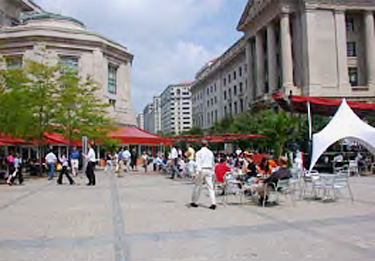
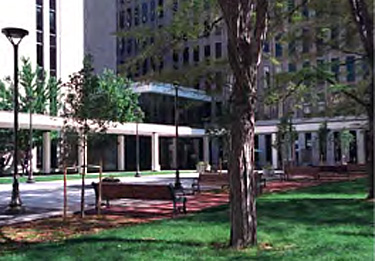
Inside the secure perimeter, maximize opportunities to create attractive, usable spaces. Plazas, parks, and other public areas provide amenities for building users and neighbors, while helping to integrate the perimeter with the site and its surroundings.
Building Blocks for Effective Site Security
GSA follows security standards, developed by the Interagency Security Committee (ISC), that outline required analysis and performance benchmarks for federal buildings. Under the ISC Security Design Criteria, agency or contractor security experts perform risk assessments, blast analyses, progressive collapse analyses, and other assessments to identify threats and calculate a building's response to them.
Although some federal agencies have security standards that differ slightly from or supplement the ISC criteria, all federal criteria generally address the same types of threats and countermeasures. However, performance criteria may vary in their assumptions about potential threats and the required performance level of a building's structure and façade.
ISC criteria focus on deterring and mitigating threats, including explosive packages or vehicles; preventing and expelling attacks stemming from chemicals or biological agents; and controlling access to and improving surveillance in and around the property. The site security elements described in this page are meant to prevent these threats from reaching the vulnerable areas of a facility with an understanding that a certain level of risk must be accepted.
The concept of site "zones" is introduced here as the framework for individual element types. Each element is described in detail in relation to its corresponding site zone. Each section also highlights recent innovations and new technologies to help formulate an integrated, comprehensive, and cost-effective approach that supports the hallmarks of a great project.
Zones
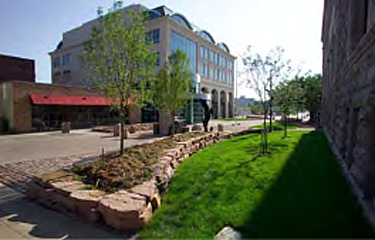
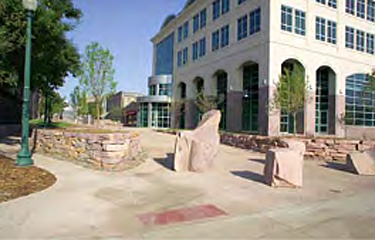
This public street, located between an existing courthouse and a new federal lease construction project, was closed to enhance perimeter security. Working with the city, the Project Team redeveloped the street into a public plaza. Both parties now are working together to manage programmed activities in the space, providing amenities to federal users and an adjacent retail district.
By focusing on zones of the site, the design team can better understand context and how security elements and amenities in each zone contribute to the performance of elements in the others. The particular elements found in each of six security zones are included, with guidelines for their use and best practices.
Zone 1: Neighborhood
Zone 2: Standoff Perimeter
Zone 3: Site Access and Parking
Zone 4: Site
Zone 5: Building Envelope
Zone 6: Management and Building Operations
This broader view can guide decision-makers through a strategic, comprehensive, collaborative, and long-term-focused design process. The site security zones, as illustrated below, follow the physical organization of a site from the outside (Zone 1) to the inside (Zone 6). Each zone offers opportunities to increase site security and enhance site appearance and function. In the first zone, the team considers the site's context within its neighborhood. For successive zones, the team explores opportunities to protect the site by making adjustments to its perimeter, circulation, and program and concludes by recommending changes in space planning or security operations, to minimize vulnerabilities. A Summary of Security Zones and the Elements and Actions to consider is presented below.
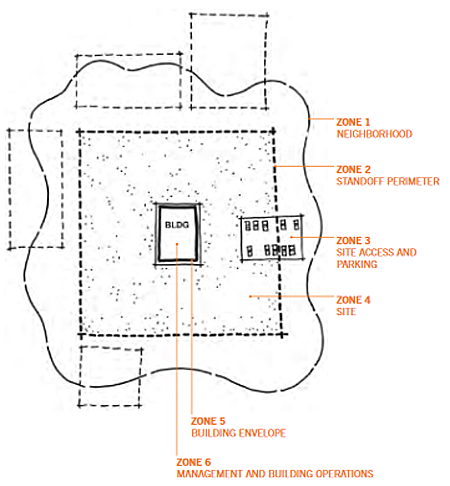
This diagram shows a general representation of the six security zones superimposed on a hypothetical site. The dimensions and area of each zone and arrangement of elements vary per project, based on site conditions and project scope.
Credit: GSA Site Security Design Guide
| ZONES | ELEMENTS / ACTIONS |
|---|---|
| Zone 1 Neighborhood | |
| This can be an area of one or more blocks surrounding a facility, depending on how the site is used. It may include streetscape, public spaces, parking lots, and other facilities that visitors frequent. Opportunities: Site treatments include architectural, visual, and public-use cues. Neighborhood-based solutions, such as operational security and traffic guidance/control countermeasures, are also effective. |
|
| Zone 2 Standoff Perimeter | |
| A security perimeter keeps vehicle-borne explosives at a distance, thus reducing potential destruction and harm. Depending on the risk analysis, the perimeter may require secured or unsecured standoff. Opportunities: Enhancements to the functionality and aesthetics of the site for the public, employees, and visitors are possible, while satisfying standoff needs. |
|
| Zone 3 Site Access and Parking | |
| Various elements and services provide and control access to a facility. This zone can include the inspection of both vehicles and visitors. Opportunities: Satisfying security requirements can also promote effective access, natural surveillance, and increased convenience for those who use the facility. |
|
| Zone 4 Site | |
| Once within the security perimeter, the site zone may provide an additional layer of elements, or hardening, to assist in deterring or preventing the destruction of or harm to a facility. With a sufficiently hardened perimeter, the site zone's primary role would be to serve more as a welcoming public space, with amenities, programs, and activities that serve building tenants, visitors, and the larger community. Opportunities: Site features, such as reflecting pools, benches, and security pavilions on the site and inside the standoff zone perimeter, may offer enhanced security, safety, and amenities. |
|
| Zone 5 Building Envelope | |
| Control of heating, ventilation, and air-conditioning (HVAC) vents/air intakes; location and operation of entry and egress points; additional surveillance by security personnel or cameras; and lighting occur at the interface between site and building. Opportunities: Security improvement may also increase everyday safety of the site. |
|
| Zone 6 Management and Building Operations | |
| Building programs and layout can be modified to increase security, such as moving high-risk tenants to the interior of the facility. Additional security personnel can also be added to increase surveillance. Opportunities: Modifications to space planning and building operations can reduce some risk, without changing the site itself. |
|
Vector analysis provides useful information about how street design can work in concert with physical barriers to prevent vehicles of a certain size and speed from reaching a site. Reducing the achievable size and speed allows the design team to be more flexible when selecting perimeter security measures. This technique is a key tool in determining a comprehensive site design and eliminating unnecessarily robust countermeasures.
Successful Site Design
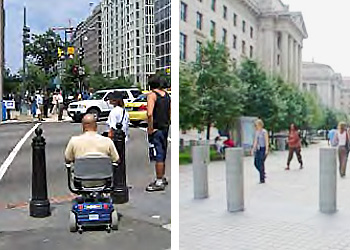
Perimeter elements must not block easy access to curbs by either pedestrians or wheelchair users (left). In high-traffic areas, designers should look for ways to position or stagger elements to meet security performance requirements, while allowing for comfortable circulation (right).
As Project Team members consider each zone during the site security design process, they must keep two crucial factors in mind:
-
Comprehensive approach. A long-term development strategy and a comprehensive site design should be developed early to provide sufficient funding (e.g., during the Feasibility Study for Prospectus-level projects) and guide the life of the project. The team should integrate all aspects of the security requirements into the overall project requirements and design directives. Understanding all components that contribute to the plan is necessary to establish priorities and phased implementation if this becomes necessary.
-
Flexibility. Innovative design concepts should have the flexibility to respond to future changes in agency mission, operations, or budgets. Since physical improvements have a longer usable life than initial planning assumptions, design solutions that are multifunctional and seamlessly integrated into the site and building are able to serve the facility efficiently over time, as needs change. Best practice for site security design includes the selection of elements that support security functions in multiple ways, by providing the following:
- Physical deterrence. Sites may include hardened perimeter elements that enforce the standoff zone, the distance between potential explosions and the building.
- Psychological deterrence. Some sites are designed so that their security is very obvious and almost forbidding. For other sites, the team may choose a more subtle approach that does not call attention to the site as a potential target.
- Clear expectations for use. Sites can be organized to indicate which types of activities are welcome and which are not.
- Support for observation, surveillance, and inspection. Sight lines and vistas can be designed to provide natural opportunities for observation of those approaching the building, or to block views of sensitive areas.
- Acceptance of allowable risk. If the Project Team determines that no reasonable means exist to significantly reduce a risk, the ISC criteria allow for acceptance of risk. Something can always be done, and the team has the ability to decide the extent of the chosen methods and actions.
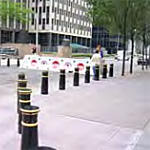
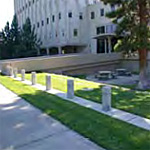
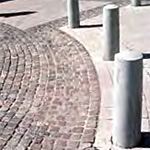
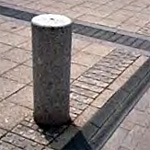
Mounting surfaces play a fundamental role in how bollards "read." Even high quality bollard treatments won't present well if surrounding surfaces are of inferior quality (far left). However, otherwise austere bollard designs can work quite well when paired with appealing surface treatments (right three).
Application
Campus Renovation/Suburban Location
This federal complex comprises six buildings, with a similar architectural style, built during the same decade. There are three multistory office buildings, two support buildings, one storage building, and multiple surface parking areas. A chain link fence encloses the entire complex. Both of the support buildings are redundant for the campus, and the storage building is underutilized. There are no exterior public spaces programmed for building tenants to eat, sit, or participate in other outdoor activities.
The main federal building houses five tenant agencies: four with an ISC security rating of medium, and one with a low-risk rating. The secondary building contains multiple agencies, all rated medium. The high-risk building has a single tenant agency with a high ISC security rating. All occupied federal buildings are able to achieve a minimum standoff of 50 feet from the surrounding streets.
The perimeter chain link fence disconnects the majority of the complex from the surrounding residential neighborhood. There are multiple vehicular entries and large areas of poorly lit surface parking throughout the site, making it difficult for guards to monitor both vehicles and pedestrians. To further complicate matters, the vehicular and pedestrian circulation systems are not clear, and the few wayfinding signs are confusing.
During the initial development of the complex, a portion of Second Street from Center Drive to Highway 101 was closed. An elevated freeway borders the site to the south, and recently, a lively retail corridor has been developing to the east, across Highway 101. (For the complete test case, please click here.)
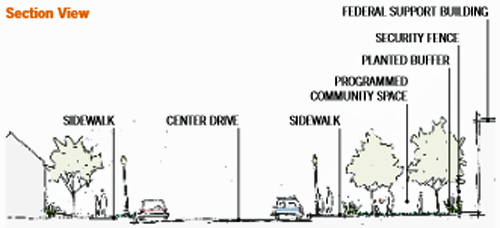
Section view of proposed security design solution: To activate the campus edge, the site security fence is pulled inside the property line, creating spaces large enough for a federal–community partnership to program as parks. Providing park space for the community contributes to positive public perception of the federal facility and better utilizes what would otherwise be a neglected and poorly monitored area of the site.
Credit: GSA Site Security Design Guide, Chapter 2
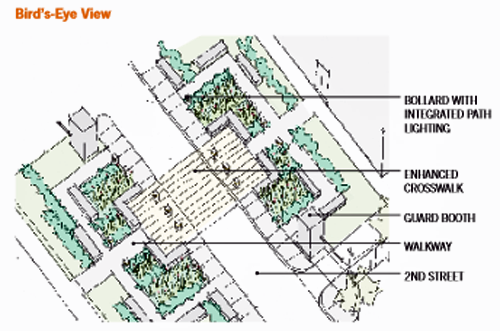
Bird's-eye view of proposed security design solution: A formal entry/campus quadrangle (quad) is created perpendicular to Second Street. An enhanced pedestrian crosswalk provides safe crossing, and a landscaped median helps to slow traffic. The quad seating areas are placed along axial, garden-lined pedestrian paths. Reinforced site furniture along the paths establishes a perimeter, without requiring lines of bollards.
Credit: GSA Site Security Design Guide, Chapter 2
Suburban federal complexes often encompass enormous acreage and border low-density land uses, such as residential or commercial neighborhoods. These conditions offer improvement opportunities that differ from those of their urban counterparts. In fortifying the perimeter of a multi-building complex, for example, Project Teams may find opportunities to improve the sustainability of a site. Bioswales—sloped, vegetated channels that help clean surface runoff water—both mitigate the negative impact created by substantial paved areas in such complexes and offer the security benefits of a ditch or moat. Land along the perimeter of a site provides opportunities for public use space, including small parks or sports fields.
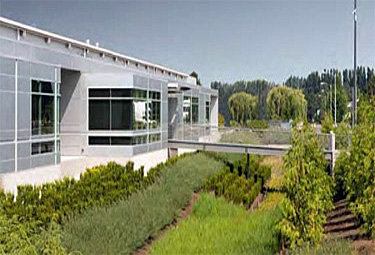
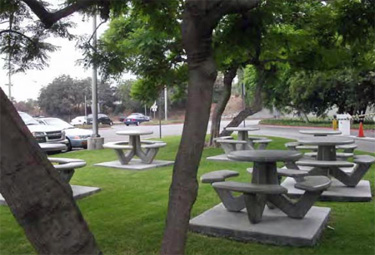
For additional case studies, please see: the Site Security Design Case Study.
Additional Resources
Publications
- Facility Security Level Determinations for Federal Facilities. An Interagency Security Committee Standard. For Official Use Only
- Federal Facility Security Committee Standard. An Interagency Security Committee Document. For Official Use Only.
- Physical Security Criteria for Federal Facilities. An Interagency Security Committee Standard. For Office Use Only.
- The Design-Basis Threat (U). An Interagency Security Committee Report. For Official Use Only.
- National Infrastructure Protection Plan by Department of Homeland Security. 2006.
- Perimeter Security for Historic Buildings by General Services Administration. 2003.
- U.S. Courts Design Guide by Judicial Conference of the United States. Revised 2021.
- U.S. Land Port of Entry Design Guide by General Services Administration and Department of Homeland Security. March 2006. For Official Use Only.
- Vulnerability Assessment of Federal Facilities by Department of Justice. June 1995. For Official Use Only.
Note: These security documents are updated frequently, and new standards are released regularly. The DHS Interagency Security Committee Policies, Standards, and Best Practices has the most up-to-date information. Because some of these materials are not available to the general public, Project Team members should contact OCA staff for access.
Project Teams must be aware of which of these criteria are pertinent to their particular design problem. Since all of the applicable references accommodate balanced, flexible decision-making, they should be used in conjunction with The Site Security Design Guide to develop custom solutions.








